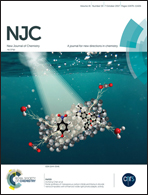Study of molecular structure, chemical reactivity and H-bonding interactions in the cocrystal of nitrofurantoin with urea†
Abstract
The cocrystal of nitrofurantoin with urea (C8H6N4O5)·(CH4N2O), a non-ionic supramolecular complex, has been studied. Nitrofurantoin (NF) is a widely used antibacterial drug for the oral treatment of infections of the urinary tract. Characterization of the cocrystal of nitrofurantoin with urea (NF–urea) was performed spectroscopically by employing FT-IR, FT- and dispersive-Raman, and CP-MAS solid-state 13C NMR techniques, along with quantum chemical calculations. With the purpose of having a better understanding of H-bonding (inter- and intra-molecular), two different models (monomer and monomer + 3urea) of the NF–urea cocrystal were prepared. The fundamental vibrational modes were characterized depending on their potential energy distribution (PED). A combined experimental and theoretical wavenumber study proved the existence of the cocrystal. The presence and nature of H-bonds present in the molecules were ascertained using quantum theory of atoms in molecules (QTAIM) and natural bond orbital (NBO) analysis. As the HOMO–LUMO gap defines the reactivity of a molecule, and this gap is more for the API than the cocrystal, this implies that the cocrystal is more reactive. Global descriptors were calculated to understand the chemical reactivity of the cocrystal and NF. Local reactivity descriptors such as Fukui functions, local softness and electrophilicity indices were analysed to determine the reactive sites within the molecule. The comparison between NF–urea (monomer) and NF showed that the cocrystal has improved overall reactivity, which is affected by the increased intermolecular hydrogen bond strength. The docking studies revealed that the active sites (C![[double bond, length as m-dash]](https://www.rsc.org/images/entities/char_e001.gif) O, N–H, NO2, N–N) of NF showed best binding energies of −4.89 kcal mol−1 and −5.56 kcal mol−1 for MUL and 1EGO toxin, respectively, which are bacterial proteins of Escherichia coli. This cocrystal could potentially work as an exemplar system to understand H-bond interactions in biomolecules.
O, N–H, NO2, N–N) of NF showed best binding energies of −4.89 kcal mol−1 and −5.56 kcal mol−1 for MUL and 1EGO toxin, respectively, which are bacterial proteins of Escherichia coli. This cocrystal could potentially work as an exemplar system to understand H-bond interactions in biomolecules.

- This article is part of the themed collection: SBQ-RSC: Celebrating UK-Brazil collaborations


 Please wait while we load your content...
Please wait while we load your content...